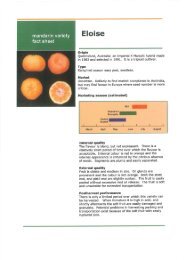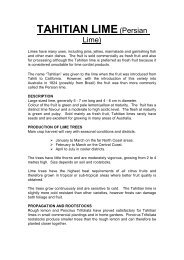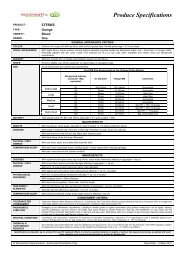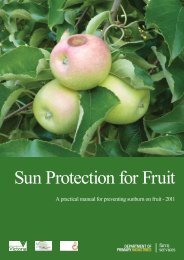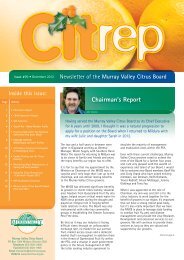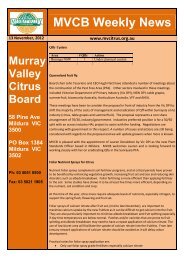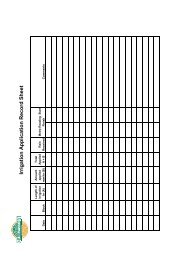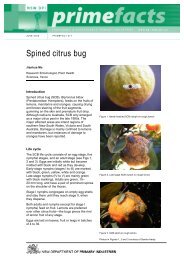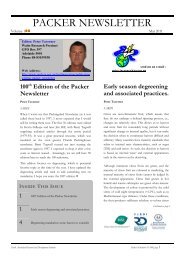ANNUAL REPORT 2005 - MVCB - Murray Valley Citrus Board
ANNUAL REPORT 2005 - MVCB - Murray Valley Citrus Board
ANNUAL REPORT 2005 - MVCB - Murray Valley Citrus Board
You also want an ePaper? Increase the reach of your titles
YUMPU automatically turns print PDFs into web optimized ePapers that Google loves.
Business Environment<br />
INTRODUCTION<br />
The <strong>MVCB</strong> provides research and market development services to 468 citrus growers in both<br />
New South Wales and Victoria from Sunraysia to Echuca/Moama and areas around Kyabram and<br />
Wangaratta.<br />
<strong>Citrus</strong> is Australia’s largest fruit export industry and Sunraysia accounts for approximately 50%<br />
of national citrus exports.<br />
GLOBAL MARKET<br />
Export Market Access and Development<br />
Overall, it is difficult to sum up the world situation in a meaningful manner as circumstances are<br />
constantly changing. In terms of our market window, existing markets are oversupplied and<br />
under intense competition from South Africa and other suppliers.<br />
The high Australian dollar, difficult trading protocols and protracted negotiations in market<br />
access (particularly China) have compounded to make returns to growers extremely poor. The<br />
USA market has been the only one to indicate the prospect of a profit.<br />
In balance, this Navel season has been a total disaster for the citrus industry. Currently, there are<br />
reduced export market opportunities, a large volume of fruit coming into production (through the<br />
planting of new Navel varieties grown to fill expected new and existing export markets), and<br />
cheap imported orange juice (both not-from-concentrate and concentrate). The imported product<br />
has filled Australian cool rooms, and resulted in processors informing the citrus industry that they<br />
do not require any Navels for juice this year.<br />
It is also anticipated that the <strong>2005</strong>/06 Valencia orange crop will total approximately 300,000<br />
tonnes across the Southern growing regions. The <strong>MVCB</strong> area is expected to produce some<br />
53,000 tonnes despite large numbers of tree removals and topworking to new varieties to respond<br />
better to anticipated market demand for fresh fruit rather than juicing<br />
Growers in particular will need to consider strategies to address this projected large crop.<br />
The system developed by the <strong>MVCB</strong> to monitor the harvest rate, market demand and compile<br />
reports on a weekly basis to industry has been introduced. Reviewing the national promotion<br />
plan for Valencias in the domestic market is on the agenda, as is looking at ways the industry can<br />
build on the current “Buy Australian” swell of interest and apply it to fresh juice.<br />
Biosecurity Issues<br />
The detection of citrus canker in July 2004, in the Emerald area of Queensland, is of considerable<br />
concern to the entire industry. It is the biggest issue nationally for both export and domestic<br />
markets. The proposed Biosecurity Levy is currently receiving informed consideration.<br />
DOMESTIC MARKET<br />
Overview<br />
Supply and demand problems have led to a number of adverse marketing conditions.<br />
A background of increasing seasonal competition from other fruits and a declining share of the<br />
retail dollar has made the local market almost unviable for oranges. However, the sale of<br />
mandarins has gone against this trend.<br />
Low frozen concentrate orange juice prices and large inventories have meant there is no demand<br />
for overrun or factory fruit.<br />
The large “on crop” Valencia forecast for <strong>2005</strong>/06 will require growers to take reduction<br />
strategies such as hedging their trees as soon as possible. This will have the effect of reducing the<br />
<strong>2005</strong>/06 crop in terms of quantity and potentially improve the demand for <strong>2005</strong>/06 fruit. It could<br />
also result in lower picking costs.<br />
Page 10




